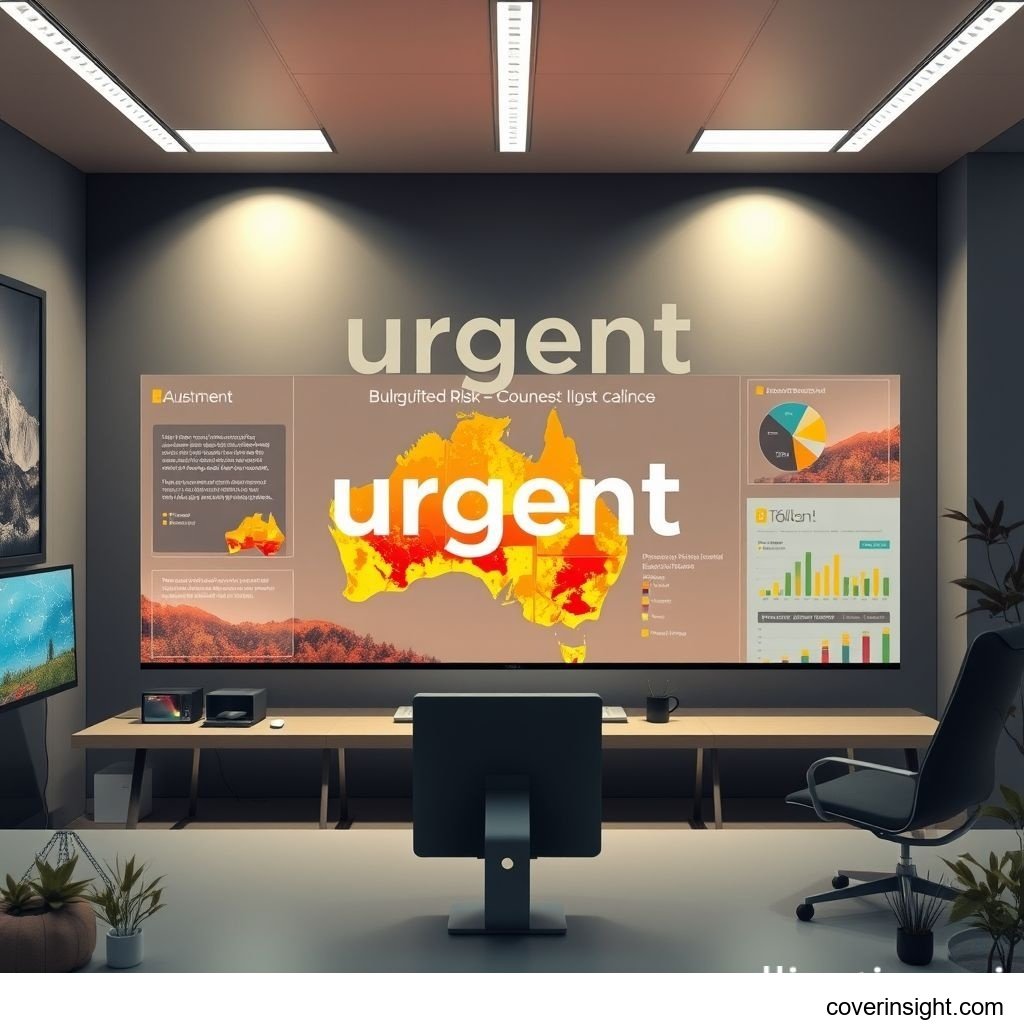Introduction
Australia, a land of breathtaking landscapes, is also increasingly prone to natural disasters, with bushfires being a significant and recurrent threat. As we approach 2025, a critical shift is underway regarding how these risks are assessed and managed. The impending bushfire risk mapping changes in Australia are set to redefine how insurers calculate premiums and offer coverage, making it crucial for homeowners and businesses to understand these updates. These changes reflect an evolving understanding of climate patterns and their direct impact on property vulnerability, underscoring the importance of adequate and up-to-date insurance protection. This comprehensive guide will navigate the complexities of these new policies, offering clarity on what to expect and how to prepare for the future of disaster coverage.
Navigating the New Landscape: Understanding Bushfire Risk Mapping Changes
The forthcoming bushfire risk mapping changes are more than just administrative adjustments; they represent a fundamental re-evaluation of how natural disaster risks are understood across the continent. These revisions are driven by advanced geospatial technology, updated climate data, and lessons learned from recent catastrophic fire seasons.
The Evolution of Bushfire Risk Mapping
Historically, bushfire risk mapping relied on broad, regional assessments. However, the 2025 updates will introduce a granular, property-specific approach. This means:
-
High-Resolution Data: Utilisation of satellite imagery, LiDAR, and drone technology to capture precise topographic and vegetation data.
-
Advanced Modelling: Sophisticated algorithms simulating fire behaviour under various weather conditions, considering fuel load, slope, and wind patterns.
-
Dynamic Assessments: The maps may be updated more frequently to reflect changes in environment, such as new developments or significant bushfire events that alter landscapes.
These enhanced maps aim to provide insurers with a more accurate picture of individual property risk, which will directly influence policy availability and pricing. For policyholders, it means a clearer understanding of their specific exposure.
Impact on Property Valuations and Insurance Premiums
The direct consequence of these detailed bushfire risk mapping changes will be felt in property valuations and, most notably, insurance premiums. Properties previously considered low-risk might find themselves reclassified, leading to potential premium increases. Conversely, some properties might see their risk profile improve.
-
Premium Adjustments: Insurers will adjust premiums based on the new risk categorisations. High-risk areas will likely see higher costs to cover increased exposure.
-
Valuation Considerations: Property valuers will incorporate the new risk classifications, potentially impacting market values, especially for homes in newly identified high-risk zones.
-
Underwriting Decisions: Insurers may refine their underwriting criteria, potentially imposing stricter conditions or offering different types of policies for properties in extreme risk areas.
It's vital for property owners to proactively assess how these mapping changes might affect their specific location and financial planning.
Regional Disparities and Natural Disaster Coverage News
The new bushfire risk mapping changes will inevitably highlight regional disparities in risk exposure. Areas bordering national parks, dense bushland, or those with specific topographical features conducive to fire spread will see heightened scrutiny. This focus is also part of a broader trend in natural disaster coverage news, where insurers are increasingly tailoring policies to specific, localised risks.
-
Targeted Prevention: Communities identified as high-risk may become priorities for government and local council mitigation efforts, such as prescribed burning programs and community fire breaks.
-
Community Preparedness: There will be an increased emphasis on community-level preparedness and evacuation plans in these newly delineated high-risk zones.
-
Coverage Availability: While general natural disaster coverage will remain, specific add-ons or tailored policies for bushfire risk might become more prevalent, reflecting the nuances of localised threats. Staying informed about natural disaster coverage news will be key to ensuring comprehensive protection.
Coverage Details: Essential Natural Disaster Coverage News
Understanding your insurance policy is more critical than ever, especially with the shifting landscape of natural disaster coverage news. As the bushfire risk mapping changes come into effect, knowing what’s covered and what isn’t will prevent unwelcome surprises in the aftermath of a disaster.
What’s Included in Bushfire & Disaster Policies
A comprehensive bushfire and disaster policy typically offers protection against a range of perils. While specifics vary by insurer, common inclusions often cover:
-
Property Damage: This is the core component, covering structural damage to your home and other buildings (e.g., sheds, garages) on your property due to fire, smoke, explosion, or suppression efforts.
-
Contents Coverage: Protection for personal belongings inside your home, including furniture, appliances, clothing, and valuables, against fire-related damage.
-
Temporary Accommodation: If your home becomes uninhabitable due to insured damage, policies often cover the cost of temporary accommodation and associated living expenses.
-
Debris Removal: Costs associated with clearing debris and rubble from your property after a fire or disaster.
-
Rebuilding Costs: Coverage for the expenses involved in rebuilding your home to current building codes and standards.
-
Liability: Protection if an incident on your property causes injury or damage to others.
It’s crucial to review your policy wording carefully, paying close attention to the sum insured, which should accurately reflect the replacement cost of your property and contents. For general guidance, explore resources on global insurance at Insurance Resources Global.
Common Exclusions and Gaps in Protection
While policies aim to be comprehensive, there are typical exclusions that policyholders must be aware of to avoid gaps in their protection. These often include:
-
Underinsurance: If your sum insured is less than the actual cost to rebuild or replace, you may only receive a partial payout.
-
Pre-existing Damage: Damage that existed before the policy was taken out or before a specific event.
-
Negligence: Damage resulting from a lack of reasonable care or maintenance of the property.
-
Landscaping: Trees, shrubs, and gardens are often not covered for fire damage.
-
Specific Perils: While a broad "natural disaster" policy covers many events, some specific perils (e.g., landslides not caused by covered events, or acts of war) might be excluded.
-
Government-Mandated Events: Some policies may have specific clauses regarding damage caused by government-mandated mitigation efforts (e.g., backburning that gets out of control, though this is rare).
Understanding these exclusions is paramount. Consulting with your insurer or a reputable broker is advisable to clarify any ambiguities and ensure your coverage aligns with your property’s unique risks. For deeper insights into Australian-specific insurance matters, visit AU Insurance Home.
Cost Analysis: Decoding Premiums Amidst Bushfire Risk Mapping Changes
The forthcoming bushfire risk mapping changes are set to be a significant driver of insurance premium adjustments across Australia. Understanding the factors that contribute to your premium is essential for managing your insurance costs effectively and ensuring you receive fair value.
Price Factors Influencing Your Premium
Several key elements come into play when insurers calculate your premium, especially concerning bushfire and disaster coverage:
-
Location, Location, Location: This remains the most dominant factor. With the new bushfire risk mapping changes, properties in areas with a higher assessed bushfire risk will almost certainly face higher premiums. Proximity to bushland, vegetation density, and topographical features (e.g., steep slopes) are critical.
-
Property Characteristics:
-
Construction Materials: Homes built with fire-resistant materials (e.g., brick, concrete, metal roofs) typically attract lower premiums than those made of more combustible materials (e.g., timber).
-
Age and Condition: Older homes or those in poor repair may incur higher premiums due to perceived higher risk.
-
Defensible Space: The creation of a "defensible space" around your property, clearing vegetation and potential fuel sources, can positively influence your premium.
-
Fire-Resistant Features: Installation of sprinkler systems, ember-proof screens, and fire-rated doors can also lead to discounts.
-
-
Sum Insured: The total amount you are insured for, reflecting the cost to rebuild your home and replace contents, directly impacts your premium. Underinsuring is risky, but over-insuring is costly.
-
Claims History: Your personal claims history, as well as the claims history of your specific geographic area, can influence premium calculations. A high number of claims in your postcode might drive up costs for everyone.
-
Deductible/Excess: Choosing a higher excess (the amount you pay upfront in the event of a claim) usually results in a lower premium.
-
Insurer’s Risk Appetite: Different insurers have varying risk assessment models and appetites, meaning premiums for the same property can differ significantly between providers. This is a crucial area for comparison.
Strategies for Saving on Insurance Costs
While the bushfire risk mapping changes may introduce challenges, there are proactive steps you can take to mitigate premium increases and potentially find savings:
-
Shop Around and Compare Quotes: Never settle for the first quote. Obtain multiple quotes from different insurers to find the most competitive rates. Websites and brokers can facilitate this.
-
Increase Your Excess: Opting for a higher excess amount can significantly reduce your annual premium. Just ensure you can comfortably afford the excess if you need to make a claim.
-
Improve Property Fire Resilience:
-
Maintain a clear defensible space around your home (e.g., clear gutters, trim overhanging branches, remove combustible materials).
-
Install ember-proof mesh on vents and windows.
-
Consider upgrading to fire-resistant building materials if undertaking renovations.
-
Ensure easy access for fire services.
-
-
Bundle Policies: Many insurers offer discounts if you bundle multiple policies, such as home and contents, car, or landlord insurance.
-
Review Your Sum Insured Annually: Ensure your sum insured accurately reflects current rebuilding costs. Using online calculators or professional valuations can help avoid over- or under-insurance.
-
Seek Discounts: Ask your insurer about available discounts, such as loyalty discounts, no-claims bonuses, or discounts for direct debit payments.
-
Understand Your Risk Profile: With the new mapping, engage with your insurer to understand how your property is specifically rated and what actions you can take to reduce its risk profile.
-
Professional Advice: Consult with an insurance broker. They have extensive market knowledge and can often find policies tailored to your needs at competitive prices. For insights into regulatory oversight of financial institutions, including insurers, refer to the Australian Prudential Regulation Authority.
Preparing for 2025: Actions for Policyholders Amidst Bushfire Risk Mapping Changes
The implementation of the new bushfire risk mapping changes in 2025 is not just an insurer's concern; it's a call to action for every property owner. Proactive engagement and comprehensive preparedness are essential to navigate these shifts successfully.
Proactive Steps for Risk Mitigation
Taking direct action to reduce your property's bushfire risk can yield tangible benefits, not only in terms of safety but potentially also in insurance premiums.
-
Create and Maintain a Defensible Space: This is paramount. Regularly clear gutters, prune trees, remove dry leaves and branches, and keep grass short within 20 metres of your home.
-
Harden Your Home:
-
Install metal mesh screens on windows and doors to prevent ember entry.
-
Seal gaps in exterior walls and eaves.
-
Consider fire-resistant building materials for roofs, walls, and decks.
-
Ensure appropriate water supply and access for firefighting.
-
-
Develop a Bushfire Survival Plan: Work with your family to create and regularly practice a clear plan, including triggers for leaving, evacuation routes, and meeting points.
-
Engage with Local Authorities: Stay informed about local fire danger ratings, community fire preparedness programs, and planned mitigation activities in your area.
-
Document Your Property: Keep an up-to-date inventory of your home's contents, ideally with photos or videos, to simplify any potential claims process. Store this securely off-site or in the cloud.
These actions not only make your property safer but demonstrate a commitment to risk reduction that insurers may acknowledge.
Understanding Broader Policy Implications, Including Medicare Changes Updates
While the primary focus is on property insurance, major shifts like the bushfire risk mapping changes can have broader implications that policyholders should consider. A holistic approach to preparedness includes understanding how various government services and policies might interact during a disaster.
-
Emergency Service Readiness: Be aware of the funding and operational capabilities of your local fire and emergency services. Strong local support can be a buffer in extreme events.
-
Government Disaster Relief: Familiarise yourself with the types of financial assistance and support services the federal and state governments provide in the wake of natural disasters. This may include grants, loans, and psychological support.
-
Infrastructure Resilience: The new mapping data can also inform government investment in critical infrastructure resilience, such as power grids and communication networks, which are vital for recovery.
-
Community Health Services: It's also prudent to stay informed about Medicare changes updates and other health service adjustments. While not directly related to property insurance, effective health infrastructure and access to medical care become critically important in post-disaster scenarios. For example, changes to bulk billing, telehealth access, or mental health support services could impact your family's ability to receive care during or after a widespread disaster. Always check official government sources for the latest information on these broader policy changes to ensure comprehensive personal and community preparedness. The Insurance Council of Australia provides valuable industry insights and resources related to disaster preparedness and recovery.
FAQs on Bushfire Risk Mapping Changes
The introduction of bushfire risk mapping changes often raises many questions for property owners. Here are answers to some of the most common queries.
How much does bushfire risk mapping changes cost?
The bushfire risk mapping changes themselves do not directly incur a cost for homeowners in terms of purchasing the maps. These are generally publicly funded initiatives or internal tools used by insurers. However, the impact of these changes can lead to:
-
Increased Premiums: Properties identified as higher risk may see their insurance premiums increase due to the enhanced understanding of their exposure.
-
Mitigation Costs: Homeowners might choose to invest in property hardening or creating a defensible space, which incurs personal costs but can reduce risk and potentially offset premium increases over time.
-
Property Value Shifts: In some cases, the reclassification of risk could subtly influence property valuations, though this is a long-term market effect rather than a direct cost.
What affects premiums?
Beyond the new bushfire risk mapping changes, several factors influence your insurance premiums:
-
Geographic Location: Proximity to bushland, coastal areas, or flood zones.
-
Property Type & Construction: Materials used (e.g., brick vs. timber), age of the dwelling, and its overall condition.
-
Building Features: Installation of fire-resistant materials, ember-proof screens, or sprinkler systems.
-
Sum Insured: The total amount required to rebuild your home and replace contents.
-
Claims History: Both your individual claims history and the claims history of your specific postcode.
-
Chosen Excess: A higher excess generally leads to a lower premium.
-
Policy Inclusions/Exclusions: Specific coverages or limits chosen.
-
Insurer-Specific Pricing Models: Each insurer has its own risk assessment and pricing strategy.
Is it mandatory?
While home and contents insurance itself is not legally mandatory in Australia (unlike compulsory third party motor insurance), it is often a de facto requirement.
-
Mortgage Requirements: If you have a mortgage, your lender will almost certainly require you to have adequate building insurance to protect their investment.
-
Financial Prudence: Regardless of a mortgage, it is highly recommended. Without it, you would bear the full financial burden of rebuilding or replacing your home and contents after a disaster, which can be financially catastrophic.
The bushfire risk mapping changes do not alter the mandatory nature of insurance from a lender's perspective, but they do change the basis on which that insurance is priced and offered.
How to choose?
Choosing the right insurance policy amidst the bushfire risk mapping changes requires careful consideration:
-
Assess Your Needs: Determine the correct sum insured for your property and contents. Use online calculators or get professional valuations.
-
Understand Your Risk: Familiarise yourself with your property's specific bushfire risk profile as per the new mapping.
-
Compare Quotes: Obtain multiple quotes from different insurers. Look beyond just the price; compare policy features, inclusions, and exclusions.
-
Read the Product Disclosure Statement (PDS): This document outlines the terms, conditions, limits, and exclusions of the policy. Read it thoroughly.
-
Check Insurer Reputation: Look into customer reviews, claims handling efficiency, and financial stability.
-
Consider a Broker: An insurance broker can offer expert advice, compare policies from various insurers, and help you find suitable coverage for your specific risk profile.
-
Review Annually: Insurance needs change. Review your policy at renewal to ensure it still meets your requirements and reflects any changes to your property or circumstances.
Consequences of no coverage?
The consequences of not having adequate bushfire and disaster coverage, especially in light of the bushfire risk mapping changes, can be devastating:
-
Financial Ruin: You would be solely responsible for the cost of repairing or rebuilding your home, replacing all your belongings, and covering temporary accommodation. This can amount to hundreds of thousands or even millions of dollars, leading to bankruptcy.
-
Loss of Assets: Your most significant asset, your home, could be completely lost with no financial means to recover.
-
Debt: If you have a mortgage, you would still be obligated to repay it even if your home is destroyed, leaving you paying for a property that no longer exists.
-
Emotional Distress: The financial burden amplifies the already significant emotional toll of losing a home in a natural disaster.
-
Delayed Recovery: Without insurance, recovery efforts can be severely hampered or indefinitely delayed, impacting your ability to rebuild your life.
Given the escalating natural disaster risks in Australia, comprehensive insurance coverage is not just a financial product; it's a fundamental pillar of personal and community resilience. Ensure your policy is robust and aligned with the future of bushfire risk mapping changes.








Comments